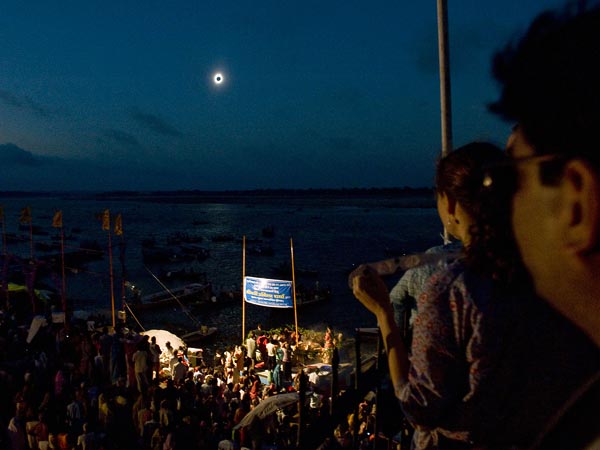Solar Eclipse Tuesday: Extremely Remote, But Visible Online Everywhere
Thousands watch a solar eclipse along the Ganges River in Varanasi, India (file picture).
A fleeting black orb will greet early-bird sky-watchers lucky enough to be in the path this week of one of the century's most remote total solar eclipses.
As the moon moves between Earth and the sun, a lunar shadow will be cast along a hundred-mile-wide (160-kilometer-wide) path, traveling virtually the entire length of the southern Pacific Ocean over several hours and making landfall early Wednesday in Australia (Tuesday afternoon in the United States).
"The best places on land to see totality"—when the sun appears to be completely blotted out by the moon—"is along 62 miles [100 kilometers] of coastline on northeast Australia, overlooking the Great Barrier Reef and the Coral Sea," said eclipse expert and National Geographic Society grantee Jay Pasachoff, an astronomer at Williams College in Massachusetts.
"Anywhere to the east, one has to be on a ship to see totality, and there are only a couple that will be in the path."
The total solar eclipse will be visible in Garig Ganak Barlu National Park in Australia's Northern Territory at about 6:35 a.m. Wednesday, local time, and then in Cairns, the only city that will be able to see totality. There, sky-watchers can enjoy two minutes of the total eclipse.
The eclipse will then sweep over the Pacific Ocean until reaching the final moments of the totality about 500 miles (800 kilometers) west of Chile's coastline at 23:48 Universal time (UT). The longest duration of totality, lasting 4 minutes and 2 seconds, will occur at 22:11 UT over the open ocean.
Meanwhile a still-striking partial eclipse—where only part of the sun is covered—will be seen within a broader track stretching for thousands of miles across much of the rest of the South Pacific Basin, including New Zealand, Antarctica, and South America.
For the lucky few along the path, astronomers recommend using either a professionally manufactured solar filter in front of a telescope or camera, or eclipse-viewing glasses that sufficiently reduce the sun's brightness and filter out damaging ultraviolet and infrared radiation (DIY alternative: Build an eclipse viewer).
Safer still: Watch a live video feed of the total solar eclipse online.
Solar Eclipse: Not Just Cosmic Eye Candy
Pasachoff, who will be down under observing his 56th solar eclipse, said there is a lot of science to be learned from the sky spectacle—particularly by monitoring of the solar corona (picture), the superheated outer atmosphere of the sun.
It's only during total solar eclipses that we can see the corona, he noted.
"We get to study the motions and dynamics of the solar corona, the variations in temperature, the effect of the solar magnetic field on the corona, and other aspects that can only be done from the ground during an eclipse—not from a spacecraft."
Andrew Fazekas
for National Geographic News
Published November 12, 2012












